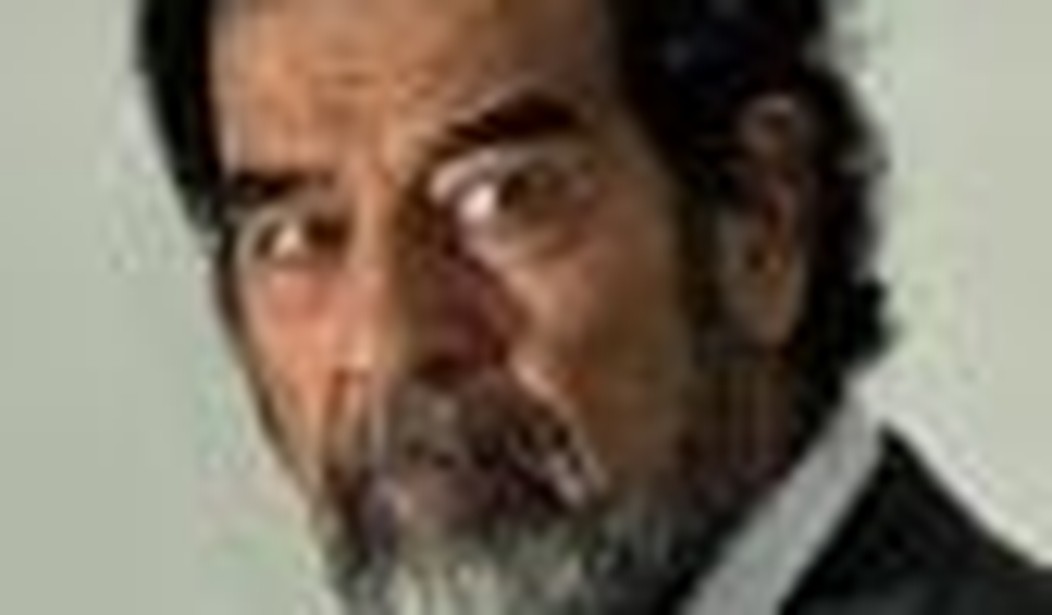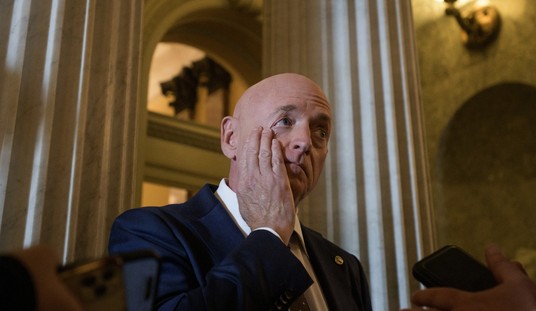The rationale for pushing forward in Afghanistan is that it is the “right” war, the “war of necessity,” the true base of the terrorists that attacked us on 9/11 and would try to attack us again. Essentially, those opposing the war in Iraq while supporting the war in Afghanistan try to frame the latter conflict as justified in every way the former is not. As the war in Iraq ever so slowly comes to a close and the history books begin being written, new evidence has emerged to challenge the narrative that the war in Iraq was something different than the war on terror.
The timing, justification, and prosecution of the war in Iraq will forever be debated, but a fair assessment of documents, studies, and testimony will show that Saddam Hussein’s regime was a supporter and active participant in radical Islamic terrorism.
The lead prosecutor of Saddam Hussein, Ja’far al-Musawi, says that he has seen official documents that prove that his regime was involved with Osama bin Laden and Ayman al-Zawahiri. Last year, a Kurdish newspaper published an Iraqi intelligence document from 2002 referencing a proposed meeting with al-Zawahiri to discuss a “revenge operation” against Saudi Arabia at Saddam Hussein’s request. If previous ties had not been maintained and if there was such hostility between the secularist government of Saddam and al-Qaeda as is assumed, such a plan would never have been hatched by Saddam or been acted upon by his intelligence service.
A source at the Iraq Memory Foundation, which is going through thousands of files to document Saddam Hussein’s reign, has reported that they have seen documents showing a link between Saddam and al-Qaeda. One document dated December 12, 1994, reveals that Uday Hussein received a message from Osama bin Laden via a Sudanese politician requesting an alliance. A meeting between bin Laden, an Iraqi government representative, and the Sudanese official then happened on January 11, 1995, where cooperation in attacking foreign forces in Saudi Arabia was discussed. The foundation said another file shows that Iraqi intelligence suggested to bin Laden that he leave Sudan for security reasons and that the ties continued after he moved to Afghanistan. Another document dated March 28, 1992, describes bin Laden as being “in a good relationship” with Iraqi intelligence in Syria. Other documents have provided immense detail of the Saddam-terror connection.
Iyad Allawi, the former prime minister of Iraq, said that his government collected proof of such ties. He said that Ayman al-Zawahiri attended the Popular Islamic Conference in Baghdad in 1999, an event chaired by the Iraqi vice president that brought together representatives of terrorist groups from around the world. Allawi said that Iraqi intelligence facilitated the travel of Ansar al-Islam operatives in the north, and he confirmed that the U.S. gave intelligence to Iraq via Jordan about the location of Abu Musab al-Zarqawi in Iraq in 2002, but the Iraqis did not take any action.
Mark Eichenlaub of RegimeOfTerror.com did an interview this summer with Matthew Degn, a former senior advisor to the Iraqi Interior Ministry and a U.S. Army civilian interrogator, about this topic. Degn said that Saddam’s government used the hawala system, which is an unofficial banking system involving a network of brokers to transfer funds with no documentation, to fund elements of al-Qaeda that were willing to work across ideological lines. Degn said that al-Qaeda had at least two training camps in Iraq, specifically in Anbar Province and the western part of the country, and that at least two cells operated, one loyal to Zarqawi and another to Egyptian Islamic Jihad. Degn also said there is evidence that Iraq sponsored attacks on American forces in Kuwait.
This is supported by the testimony of a captured terrorist who said in 2005 that al-Qaeda had a camp in Fallujah before the war began. A Time magazine article from 2003 reports that an Ansar al-Islam document describes one terrorist has having met with Abu Musab al-Zarqawi in Baghdad shortly before the war in Iraq started. In July 2008, I interviewed Don Bordenkircher, the former national director of prison and jail operations in Iraq. He said that detainees he spoke with confirmed that forces under the command of Uday Hussein gave al-Qaeda members shelter and training and that the terrorist group was able to operate in parts of Iraq under government control, specifically in Mosul and Kirkuk. Additional testimony exists to show that al-Qaeda was in Iraq prior to the war.
Iraq is also known to have harbored Abu Ibrahim, a high-level terrorist who worked with Iraqi intelligence in launching attacks in London, Rome, Athens, and Berlin. He is now in Syria, but previously “controlled a web of dangerous operatives while living in Baghdad under the protection of Saddam Hussein.” Former CIA case officer Bob Baer describes him as “the most dangerous bomb maker in the world bar none during my time as a CIA officer.”
It is often stated that the U.S. government found no evidence that Saddam Hussein sponsored terrorists, but this is patently false. The Iraqi Perspectives Project, which went through 600,000 documents, found that “the regime was willing to co-opt or support organizations it knew to be a part of al-Qaeda as long as that organization’s near-term goals supported Saddam’s long-term vision” and “Saddam supported groups that either associated directly with al-Qaeda … or that generally shared al-Qaeda’s stated goals and objectives.” Iraq operated training camps for non-Iraqi members of terrorist groups and actively supported the Army of Muhammad, an al-Qaeda affiliate in Bahrain.
The Duelfer Report concludes that Iraqi intelligence section M14 trained Iraqis, Palestinians, Syrians, Yemenis, Lebanese, Egyptians, and Sudanese nationals in terrorist tactics at Salman Pak, confirming the testimony of previous Iraqi defectors about the site that were dismissed for having an agenda. The Duelfer Report also says there is testimony that Iraq was planning to use a former member of Hamas to kill Israeli Prime Minister Ariel Sharon at the Wailing Wall in Jerusalem using unmanned aerial vehicles loaded with C4.
Iraqi intelligence was working on delivering ricin as an aerosol and “had a plan to produce and weaponize nitrogen mustard in rifle grenades and a plan to bottle sarin and sulfur mustard in perfume sprayers and medicine bottles which they would ship to the United States and Europe.” In other words, Iraq was actively working on the exact scenario the U.S. said it was overthrowing the government to prevent. Saddam may not have possessed stockpiles of weapons of mass destruction when the war began, but does it really matter so long as the capacity and intent to use such weaponry exists?
The common rebuttal to evidence such as this is that ideological differences between Saddam’s government and al-Qaeda meant that they “hated” each other and would never cooperate. The democratic Iraqi government has repeatedly asserted that such a link existed and that today members of al-Qaeda and former members of Saddam Hussein’s regime work closely. The Iraqis are threatening to cut off economic ties with Syria over that secularist regime’s ties to al-Qaeda and former Baathists working with the terrorist group. The Iraqi foreign minister is complaining about the American refusal to accept that such cross-ideological alliances can and do exist.
The debate over whether the invasion of Iraq was the right move will forever continue, and there is evidence and respectable opinion on both sides, but the argument over whether Saddam Hussein’s regime sponsored terrorism and whether cross-ideological cooperation between extremists occurs should be over.









Join the conversation as a VIP Member